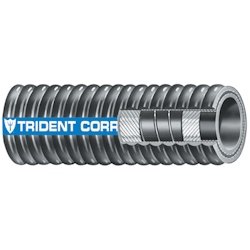When is it OK to use no-wire-helix wet exhaust hose (examples: Shields 200 series; Trident 200/110 series)? Both of these have the same rating, viz: 200F continuous and 250F intermittent; both exceed SAE J2006; and both are type R1.
I'd like to avoid wire if I can, in two separate applications, both requiring 6" i.d. hose. One is a short 4' length from mixer elbow to water lift can; the mixer outlet and the can's fibreglass inlet tube are just slightly out of alignment and bending the not-very-flexible super heavy wall'd wire reinforced stuff is difficult over this short run.
The second application is a long (11') dead-straight run from the water lift can to the torpedo muffler. The 30 year-old heavy-walled wire-reinforced hose has developed a small hole/split just before the clamps where is fastens to the muffler. I could cut this out and splice in a joiner but it would be better to replace the whole run given its age. The rigidity of the wire-reinforced stuff would require major surgery to joiner-work, whereas the non-wire stuff could be slid through, I think.
Engines are Cummins BTA 5.9 370's.
I'd like to avoid wire if I can, in two separate applications, both requiring 6" i.d. hose. One is a short 4' length from mixer elbow to water lift can; the mixer outlet and the can's fibreglass inlet tube are just slightly out of alignment and bending the not-very-flexible super heavy wall'd wire reinforced stuff is difficult over this short run.
The second application is a long (11') dead-straight run from the water lift can to the torpedo muffler. The 30 year-old heavy-walled wire-reinforced hose has developed a small hole/split just before the clamps where is fastens to the muffler. I could cut this out and splice in a joiner but it would be better to replace the whole run given its age. The rigidity of the wire-reinforced stuff would require major surgery to joiner-work, whereas the non-wire stuff could be slid through, I think.
Engines are Cummins BTA 5.9 370's.


